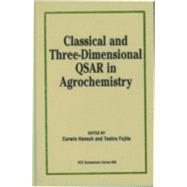
Note: Supplemental materials are not guaranteed with Rental or Used book purchases.
Purchase Benefits
What is included with this book?
| Status of QSAR at the End of the Twentieth Century | |
| Quantitative Structure-Activity and Database-Aided Bioisosteric | |
| Structural Transformation Procedure as Methodologies of Agrochemical Design | |
| Hydrophobicity Parameter of Heteroaromatic Compounds | |
| Derived from Various Partitioning Systems | |
| Theoretical Estimation ofOctanol-Water Partition Coefficient for Organophosphorus Pesticides | |
| The Calculation of Pesticide Hydrophobicity by Computer | |
| Transport Parameter Dependence on Intermolecular Forces | |
| QSARs from Mathematical Models: Systemic Behavior of Pesticides | |
| Hydrophobicity and Systemic Activities of Fungicidal Triazoles and BleachingHerbicidal Compounds | |
| The Incidence of Delayed-Type Contact Dermatitis in ModernPesticides | |
| QSARs in Environmental Toxicology andChemistry: Recent DevelopmentsI | |
| Noncongeneric Structure-ToxicityCorrelation Using Fuzzy Adaptive Least-Squares Moriguchi | |
| Computer-Aided MolecularModeling and Structure-Activity Analyses of New Antifungal Tertiary Amines | |
| QSARs and Three-DimensionalShape Studies of Fungicidal Azolylmethylcyclopentanols: Molecular Design ofNovel Fungicides Metconazole and Ipconazole | |
| Structure-Activity Relationships ofQuinone and Acridone Photosystem II Inhibitors | |
| The QSAR of InsecticidalUncouplers | |
| QuantitativeStructure-Activity and Molecular Modeling Studies of Novel Fungicides andHerbicides Having 1,2,4-Thiadiazoline Structures | |
| Applications of a New HydrophobicityParameter of Amino Acid Side Chains to Quantitative Structure-Activity Analysesof Oligopeptides | |
| Successful Application of the QSAR Paradigm in Discovery Programs | |
| Comparative QSAR: Understanding Hydrophobic Interactions | |
| Applications of Scaled Rank-Sum Statistics in Herbicide QSART | |
| Novel Structure-Activity Insights from Neural Network Models | |
| Three-Dimensional Quantitative Structure-Activity Analysisof Steroidal and Dibenzoylhydrazine-Type Ecdysone Agonists | |
| Comparison of Classical QSAR and Comparative Molecular Field Analysis:Toward Lateral Validations | |
| Distance Comparisons: A New Strategy for ExaminingThree-Dimensional Structure-Activity Relationships | |
| Table of Contents provided by Publisher. All Rights Reserved. |
The New copy of this book will include any supplemental materials advertised. Please check the title of the book to determine if it should include any access cards, study guides, lab manuals, CDs, etc.
The Used, Rental and eBook copies of this book are not guaranteed to include any supplemental materials. Typically, only the book itself is included. This is true even if the title states it includes any access cards, study guides, lab manuals, CDs, etc.